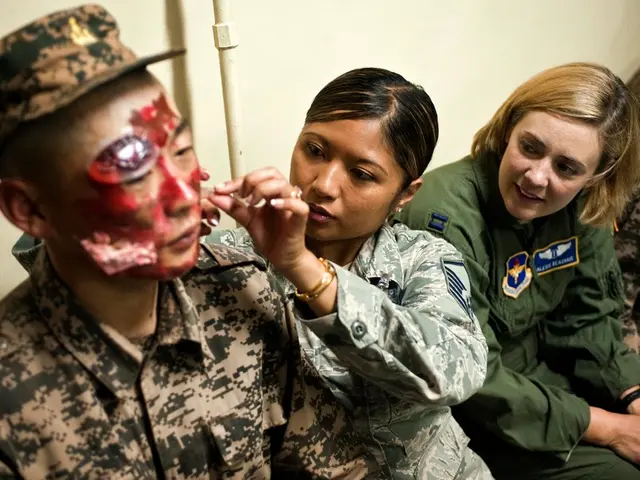Emergency Bleeding Management in Conflict Zones
Preparing for trauma care in challenging, resource-limited settings is a critical concern for medical professionals working in conflict zones and disaster-stricken areas. The latest approaches in trauma care within hostile environments are focusing on innovative training techniques, cutting-edge technologies, and essential human factors to enhance massive hemorrhage control.
Techniques and Training
Comprehensive surgical and trauma courses, such as the Hostile Environment Surgical Training (HEST) by the David Nott Foundation, offer hands-on, multidisciplinary training for emergency trauma care. These programs emphasize skills across ballistic, vascular, damage control, and other trauma fields relevant to mass bleeding and complex injuries seen in conflict zones. The training uses specialized simulators, including a human war wound simulator, for realistic practice.
Tactical Combat Casualty Care (TCCC) principles remain a core framework in these training exercises, simulating care under fire, tactical field care, and evacuation under extreme stress. These essential skills are crucial for hemorrhage control in chaotic combat conditions.
Hostile Environment Awareness Training (HEAT) integrates trauma emergency casualty care with tactical skills, focusing on rapid hemorrhage management, airway, and shock control. Practical training includes emergency tourniquet use and wound packing techniques critical to managing penetrating trauma.
Technologies
Simulation technologies using immersive scenarios, including live-action field exercises with chemical/biological and drone-attacks contexts, provide cutting-edge rehearsal for real-world hostile injury management. These techniques encourage adaptability and rapid decision-making in situations involving massive bleeding.
Advances in field-applicable blood management techniques, like chest blood reinfusion after trauma, reflect lessons learned from recent conflicts such as Ukraine. The use of realistic wound simulators supports muscle memory development for complex hemorrhage control and vascular repair under battlefield conditions.
Human Factors Influencing Trauma Care in Hostile Environments
Training emphasizes psychological resilience and teamwork under duress, preparing providers for the physical and mental stresses of care in hot, chaotic, and resource-limited environments. Multinational joint exercises foster interoperability and knowledge exchange, critical for future coalition operations where understanding different emergency procedures and technologies is vital.
Situational awareness and adaptability to rapid changes during combat, such as chemical attacks or drone strikes, are essential human factors shaping trauma outcomes, alongside mastery of hemorrhage control techniques under pressure.
Upcoming Events and Webinars
Scott King, a tactical care instructor and paramedic, is advising on hostile awareness and tactical casualty care for UK Government, NGO, and specialist responders. His webinar series, part of a larger learning opportunity on hostile medicine, is exploring hostile medicine in depth. The series has a focus on hostile medicine and will cover topics such as the critical topic of massive haemorrhage control, the use of hemostatic agents, and future developments in haemorrhage control, including AI and nanotechnology.
The webinar series is designed to complement the Hostile Environment Medicine Course in Namibia, scheduled for June. This upcoming event will provide a comprehensive learning experience for medical professionals seeking to enhance their skills in providing emergency trauma care in hostile environments.
For those interested in Scott King's expertise, he can be contacted directly via [email protected]. Scott King has over 22 years of experience in ambulance services, military instruction, and hostile environment training.
Uncontrolled bleeding remains the leading cause of preventable death in austere and high-threat settings. By focusing on advanced simulation-based training, innovative bleeding control devices and techniques, and an emphasis on human factors like teamwork, stress management, and adaptability, we can work towards improving massive hemorrhage control and overall trauma care in hostile, resource-constrained environments.
- Comprehensive surgical and trauma courses like HEST and HEAT offer training for emergency trauma care, focusing on skills relevant to mass bleeding and complex injuries in conflict zones.
- Simulation technologies that use immersive scenarios and live-action field exercises can provide cutting-edge rehearsal for real-world hostile injury management, encouraging adaptability and rapid decision-making.
- The webinar series by Scott King, covering topics such as massive haemorrhage control and future developments in haemorrhage control, is designed to complement events like the Hostile Environment Medicine Course, which aims to enhance skills in providing emergency trauma care in hostile environments.








